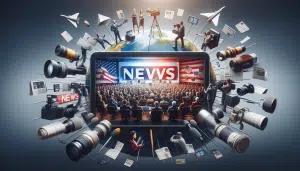Social Media’s Quiet Power Over the News You See
Lily Carter September 20, 2025
Explore how social media algorithms shape the news updates that surface on your feeds, influencing what stories gain traction and how public opinion forms. This guide explains the hidden processes, potential impacts, and what audiences should understand about today’s digital news distribution.
The Unseen Role of Social Media in News Delivery
Social media has redefined the way news spreads, often determining which headlines make it into daily conversations. Networks like Facebook, Twitter, and Instagram act as both publishers and amplifiers. Every scroll through a feed is an exercise in algorithmic selection, where millions of stories are filtered by software instructions rather than traditional newsroom judgement. This subtle switch in how information reaches the public has profound consequences for trust, speed, and accuracy in news delivery. Audiences may notice certain topics trending or see a friend’s viral post without realizing that complex coding, not impartial editors, curates these updates.
Personalized feeds capitalize on user interactions—likes, shares, and comments—to tailor content. This means two people following similar outlets might see vastly different news stories, based solely on their digital footprints. While this can increase user engagement, it can also trap individuals in echo chambers, exposing them repeatedly to familiar ideas. Researchers have flagged concerns about reduced diversity in information exposure, arguing that social media can reinforce biases and inadvertently obscure critical events (Source: https://www.pewresearch.org/journalism/2018/09/10/social-media-and-news/).
The rapid rise of mobile-first news has only accelerated this shift. Notifications, trending sections, and influencer commentary all play into the dynamic, blending hard news with entertainment and opinion. As a result, traditional news values like objectivity, depth, and verification now compete with speed, sensation, and shareability. Understanding the underlying architecture of social media platforms is crucial for anyone who wants to make sense of why some news stories surge while others fade away.
Algorithms and Headlines: Decoding the Selection Process
Social media algorithms operate behind the scenes, analyzing vast data sets to determine what appears at the top of your news feed. These mechanisms consider factors like dwelling time, reaction history, and network relationships. The exact methods are closely guarded secrets, but tech companies consistently reveal that positive engagement, such as sharing or commenting, gives certain stories a boost. As a result, emotionally charged headlines—especially those with striking language or visuals—are more likely to reach wider audiences.
However, the focus on engagement comes with trade-offs. Stories that incite outrage or fear may be given more visibility, regardless of their factual accuracy. This tendency has fueled debates about misinformation and disinformation in digital spaces. The problem becomes particularly acute during elections, crises, or health emergencies. For example, false news can spread six times faster than accurate reporting, illustrating the viral power of algorithms when unchecked (Source: https://www.science.org/doi/10.1126/science.aap9559).
Artificial intelligence and machine learning models continually refine these processes. As they learn from user behavior, their decisions can become even more opaque. Transparency remains a challenge. External watchdogs and journalists have called for platforms to open their systems for independent inspection. Until systemic change occurs, understanding these dynamics can help consumers approach online news with awareness and a critical eye.
The Echo Chamber Effect: Why Diversity Matters
Echo chambers form when people are predominantly exposed to views and news that align with their preexisting beliefs. This effect is a direct byproduct of algorithmic curation and social influence. When users regularly interact with similar perspectives—whether through likes, shares, or group memberships—social platforms fine-tune recommendations accordingly. Over time, this selective exposure creates homogenous information environments, possibly amplifying misinformation or polarization.
This concern is not just theoretical. Studies have confirmed that users in digital echo chambers become less likely to encounter dissenting viewpoints, risking a narrowing of perspective (Source: https://www.brookings.edu/articles/fake-news-and-the-spread-of-misinformation/). The phenomenon can impact everything from election results to responses to public health messages. The result is a feedback loop: news that resonates with an individual’s community rises to the fore, while alternative or challenging material is overlooked or filtered out.
Encouraging diverse content consumption is not impossible, but it takes intention. Some platforms are developing features to diversify news suggestions, while digital literacy advocates encourage regular cross-checking of stories from multiple, reputable sources. Awareness of how echo chambers form is the first step to breaking out of them, offering a more balanced and informed view of world events.
Virality and Speed: The Double-Edged Sword of Instant News
One undeniable advantage of social media is speed. Breaking news can reach millions in seconds, often before traditional channels catch up. This immediacy enables real-time awareness of crises, rapid sharing of safety instructions, or viral updates about scientific discoveries. For many audiences, it is the most efficient way to stay updated. The downside, however, is that speed can outpace accuracy, with stories sometimes gaining momentum before facts are confirmed. Corrections or clarifications rarely spread as widely as the original, erroneous story.
Virality often depends less on the importance of an event and more on its emotional impact, which can make headlines dramatic. Hashtags, memes, and influencer amplification can transform niche updates into global talking points overnight. But this openness can also fuel misinformation during crises, such as public health scares or natural disasters, putting the onus on the public to sort fact from fiction (Source: https://www.ncbi.nlm.nih.gov/pmc/articles/PMC7788592/).
Some platforms are attempting to slow the spread of unverified news through labeling systems, prompts to read articles before sharing, or partnerships with fact-checkers. While helpful, these steps are just the beginning. Individual responsibility and critical thinking remain essential safeguards against the pitfalls of viral misinformation. The balance between speed and reliability is a defining challenge of today’s news era.
How Social Platforms Influence Public Opinion and Civic Discourse
News shared and discussed on social media doesn’t just inform—it shapes opinions and even policy debates. Hashtags can launch campaigns, while viral posts can spotlight overlooked injustices or amplify marginalized voices. Digital platforms offer a direct line between grassroots events and global audiences, often bypassing traditional gatekeepers. The result is that societal conversations evolve rapidly, influenced by the latest developments and user reactions in real time.
The influence can be positive. Online campaigns have raised awareness for humanitarian relief, mobilized voters, and raised donations in unprecedented ways. However, this directness also invites challenges. Coordinated misinformation, harassment, or manipulation by bots can distort the conversation, swaying public perception for private or political gain (Source: https://www.ncbi.nlm.nih.gov/pmc/articles/PMC5907272/).
Civic responsibility is therefore tightly linked with digital literacy. Recognizing credible reporting, cross-referencing facts, and understanding when a trending post reflects orchestrated rather than organic sentiment are all vital skills. As social platforms further entrench their role as primary news distributors, these competencies become increasingly important for healthy public discourse.
Building Media Literacy in the Social Age
With the overwhelming volume of news available on social media, sorting fact from fiction is a modern essential. Media literacy provides individuals with tools to evaluate sources, spot misleading headlines, and avoid spreading false information. Schools, nonprofits, and libraries have responded with programs designed to empower everyone—from students to seniors—to become savvy news consumers.
Key strategies include checking article provenance, cross-referencing suspicious claims, and understanding how visual and emotional cues are used to drive engagement (Source: https://newseu.poynter.org/). Some digital platforms have introduced prompts that nudge users to read an article in full before sharing, helping slow the momentum of potential misinformation. Fact-checking organizations and browser extensions have also gained popularity among cautious readers.
Learning to navigate social news is an ongoing process, as algorithms and news formats evolve. Active practice—such as pausing before sharing, evaluating multiple sources, and looking for author credentials—makes a meaningful difference. Building media literacy is not just about avoiding fake news; it’s about engaging more deeply with the world, understanding context, and joining a more informed public dialogue.
References
1. Pew Research Center. (2018). Social Media and News. Retrieved from https://www.pewresearch.org/journalism/2018/09/10/social-media-and-news/
2. Vosoughi, S., Roy, D., & Aral, S. (2018). The spread of true and false news online. Science, 359(6380), 1146-1151. Retrieved from https://www.science.org/doi/10.1126/science.aap9559
3. Brookings Institution. (2017). Fake News and the Spread of Misinformation. Retrieved from https://www.brookings.edu/articles/fake-news-and-the-spread-of-misinformation/
4. Cinelli, M., et al. (2021). The COVID-19 social media infodemic. PLoS ONE, 16(3), e0244340. Retrieved from https://www.ncbi.nlm.nih.gov/pmc/articles/PMC7788592/
5. Giansiracusa, N. (2018). Social Media and Misinformation. National Center for Biotechnology Information. Retrieved from https://www.ncbi.nlm.nih.gov/pmc/articles/PMC5907272/
6. Poynter Institute. (2022). Media Literacy Tools. Retrieved from https://newseu.poynter.org/







